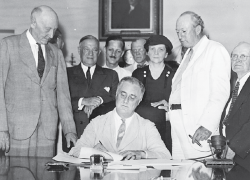 Unemployment insurance benefits supported over 53 million workers during the COVID-19 pandemic, reducing the impacts of job loss, returning an estimated $880 billion to the economy, and softening what could have been a massive labor market crisis.
Unemployment insurance benefits supported over 53 million workers during the COVID-19 pandemic, reducing the impacts of job loss, returning an estimated $880 billion to the economy, and softening what could have been a massive labor market crisis.
But the pandemic exposed shortcomings in the unemployment insurance program. State agencies struggled to handle the unprecedented surge in claims and creation of new unemployment programs. The American Rescue Plan Act (ARPA) initially allocated $2 billion (but the amount was later reduced to $1 billion) to modernize the unemployment insurance system before a new crisis arises.
The Department of Labor strategically invested ARPA funds to address critical issues in the unemployment insurance system, strengthening fraud detection and prevention, promoting equitable access, and accelerating delivery of benefits. We’ve delivered $782.9 million to 52 of 53 jurisdictions to help them achieve these goals. Here are five ways ARPA funding is modernizing the unemployment insurance system.
1. Safeguarding against identity fraud
We’re using ARPA funding to help states better use data and technology to confirm identities and prevent fraud, including a National Identity Verification Offering that provides both online and in-person verification services through the U.S. General Services’ Login.gov and the U.S. Postal Service. If you think you may be the victim of unemployment identity fraud, learn how to report this information at dol.gov/agencies/eta/UIIDtheft.
2. Equitable access through plain language and robust customer assistance
ARPA investments are propelling efforts to ensure equitable access to unemployment insurance benefits and services, such as supporting plain language initiatives. Informed by the department’s best practices, Montana streamlined its claimant notices, removing more than 500 and simplifying the language of the remaining 175. While this change is expected to help all who file with Montana, the state hopes this will help residents with lower levels of education better understand their rights and save money by reducing call center inquiries.
3. Accelerating payment timeliness
ARPA funding is supporting state adoption of modernized technologies to streamline manual processes and information exchange between states, employers, and their representatives – ensuring claimants receive benefit payments without delay. Connecticut reports using funds to promote the State Information Data Exchange System to reduce the time spent validating claims, a process traditionally done via paper and mail, and allowing benefits to be paid to eligible individuals more quickly.
4. IT modernization for improved claimant experiences
ARPA investments are driving comprehensive IT modernization initiatives that are improving claimant experiences. We teamed up with New Jersey to craft a more intuitive online application which takes claimants at least 30 minutes less to complete than the application it replaced.
5. Collaborative learning
The historic ARPA investment marks a significant step in fostering collaboration between states and the department. We’ve provided 36 states with a voluntary, no-cost assessment, state-specific recommendations, and funding for their implementation – with emphasis on fraud prevention and streamlining processes.
Improvements continue in states across the country. By aggressively combatting fraud, promoting equitable access, improving timely delivery of payments, modernizing and bolstering IT infrastructure, and fostering deeper collaboration with states, we’re leading a paradigm shift towards a more resilient, efficient and user-centric unemployment insurance system. ARPA-supported innovations are addressing immediate challenges and also laying a foundation to better meet the future needs of a diverse, modern workforce.
Read more about how ARPA is catalyzing modernization in the recent report, Insights and Successes: American Rescue Plan Act Investments in Unemployment Insurance Modernization. As we enter 2024, we are committed to continuing this work of transforming the federal-state unemployment insurance system.
Andrew Stettner is the deputy director for policy in the Office of UI Modernization within the Office of the Secretary.

 U.S. Department of Labor Blog
U.S. Department of Labor Blog


